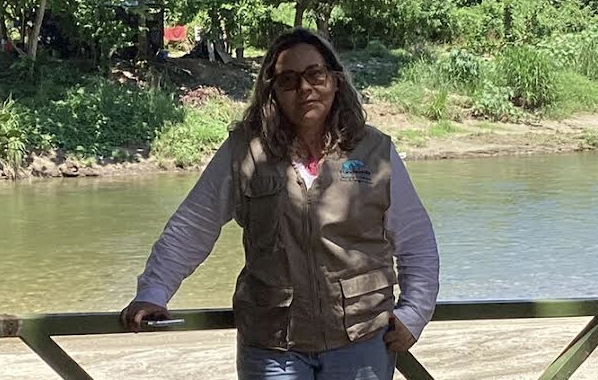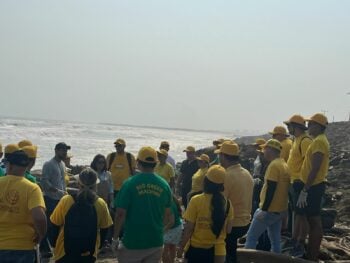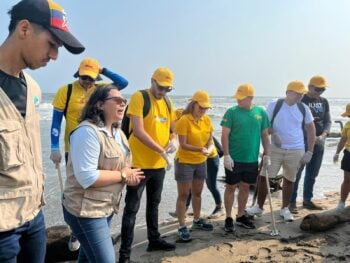Who Is Waterkeeper: Liliana Guerrero, Bocas de Ceniza Waterkeeper
By: Thomas Hynes

Liliana Guerrero has been the Bocas de Ceniza Waterkeeper since 2010. She had been living in Cartagena, Colombia, working as a law professor. A colleague of hers, Elizabeth Ramirez, was working as the Cartagena Baykeeper. Liliana was inspired by what she saw her coworker doing and decided she would like to apply something similar to her own hometown. So she asked Elizabeth for an introduction to Waterkeeper Alliance.
“I wanted to return to my city of Barranquilla,” says Lilliana. “And taking care of the environment, nature, and water has always been my passion.”
Barranquilla, which is home to over one million people, is one of the largest and most important cities in Colombia. It resides in the northern end of the country, near the Carribean Sea, and sits beside the Magdalena River. Though not the largest river in the country, it is easily the most important. More than half of the entire country lives within the Magdalena River watershed.
“The Magdalena River, I think, is the heart of the country,” says Lilliana. “It is not only economically important, but also historically and culturally.”
Unfortunately, the river faces many threats. Only about a third of wastewater is treated. The rest is dumped directly into the river. Industry is mandated to treat water before discharging, but enforcement is low and the permitting process is flawed. There are several laws on the books protecting waterways, but there is never any guarantee that all legal requirements are met. There are still many loopholes and gaps in protection. 
For example, Liliana would love to see more robust protections for PFAS protections. There are several parameters for quality standards in place, but it’s not currently enough to truly protect the watershed.
One major hurdle to Lilliana’s work is that for far too long barranquilleros (aka those from Barranquilla) had little to no access to the river. It made it hard to highlight the problems or even show what was at stake when people could barely see or experience the river. The city finally built a waterfront area about ten years ago. Barranquilla is now connected again with their river, but the issues of pollution remain.
Lililana would also like authorities to measure water quality, as required by law. Recently, the environmental authority presented to the public a new four-year plan, making it mandatory to include the monitoring of water bodies within the four-year Action Plan. Liliana requested in the participatory workshops for the construction of the Plan, that the Magdalena River be included within the bodies of water that will be monitored; If this does not happen, Liliana is ready to demand that this be done through legal means from the authority. The Magdalena River needs to be monitored in Barranquilla and the Department of Atlántico. This came about thanks to Liliana’s tireless efforts. This kind of advocacy has always come naturally to her.
“I don’t like injustice. I don’t like inequality,” says Liliana. “The only thing I can do is to use my background and career as a lawyer to try and help with all that I am. I don’t have money. I don’t have friends in high places. I’m just a lawyer who is passionate. I think this is the only way I have to protect my river and water in general.”
 Over the last four or five years, Liliana has worked on a draft bill with other organizations to better protect waterways in Colombia. But it has not been easy working with so many other groups, and last year the legislation stalled out. Undeterred, Liliana is proceeding with her own version. She believes the law will better emphasize water quality monitoring and include regulations to protect against PFAS and other chemical waste.
Over the last four or five years, Liliana has worked on a draft bill with other organizations to better protect waterways in Colombia. But it has not been easy working with so many other groups, and last year the legislation stalled out. Undeterred, Liliana is proceeding with her own version. She believes the law will better emphasize water quality monitoring and include regulations to protect against PFAS and other chemical waste.
However, even if this legislation passes, there will still be many challenges to Liliana’s watershed. For example, over 300 municipalities send their wastewater to the Magdalena River. There is also nearby mining and deforestation. Plastic pollution is also a major threat to the river. Liliana feels as though the entire country dumps their plastic into the Magdalena River and into Barranquilla and the beaches of Puertos Colombia municipality. Tragically, that waste often carries out to the Caribbean Sea and greater oceanic ecosystems.
Plastic pollution is really bad too. It is as though the entire country dumps their plastic onto Barranquilla. At one regional cleanup, or minga, they collected nearly a half ton of plastic pollution in about two hours. Not surprisingly, Bocas de Ceniza Waterkeeper is very keen on joining the Global Plastics Treaty.
For a lot of Liliana’s work, the effort is great, but the progress can feel slow. When asked what she would like to see change, she lists better sanitation systems. There’s a project she is working behind the scenes on to turn a local swamp into a protected area. She would also like to see better public awareness. Specifically, she would love to see more vulnerable people become educated about the legal tools they have to protect the environment, rights, and resources, especially the water.
“It’s not the same being a Waterkeeper in the United States as being a Waterkeeper in Latin America. We have more challenges. We are now recognized as an environmental leader. We have put the Waterkeeper Alliance name into the Colombian environmental agenda,” says Liliana. “These problems are huge. They are very big. But we are on the correct path.”